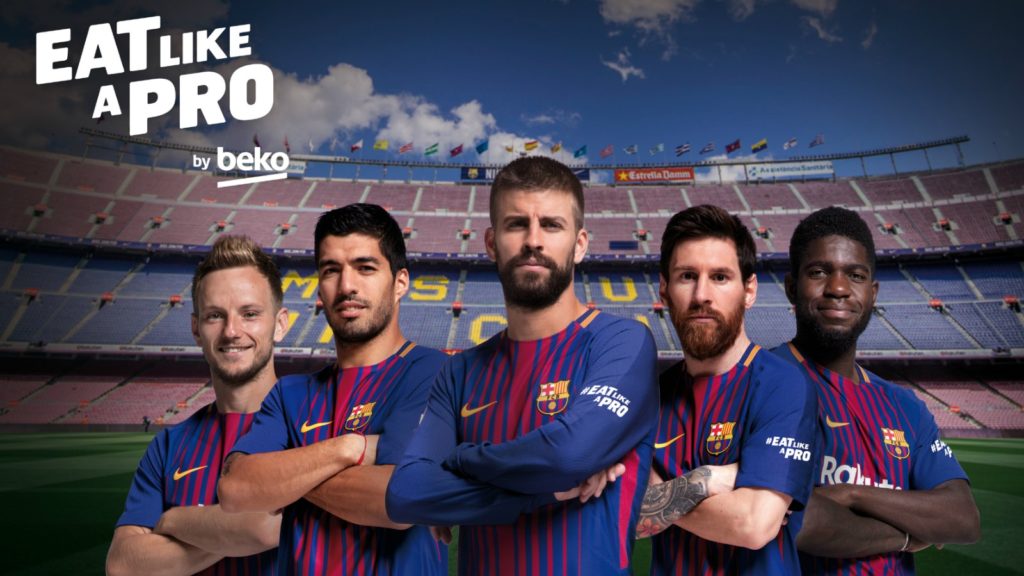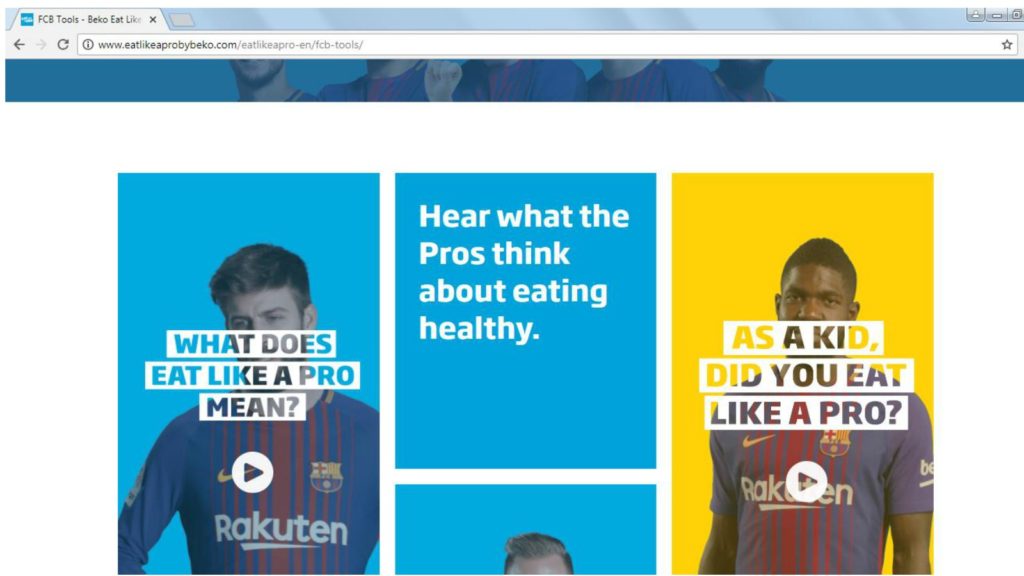Senior digital marketing manager at Beko Keval Shah talks about the company’s global #EatLikeAPro campaign, what retailers can learn from it and how the can adopt ideas for their marketing.
Appliance brand Beko launched its #EatLikeAPro healthy eating campaign earlier this year, which was supported by FC Barcelona, to tackle the global issue of childhood obesity.
In doing so, it has already helped raise €1million for the United Nations Children’s Fund (UNICEF), as well as heighten awareness of its brand.
Sponsored Video
Social media has been key to success of the campaign. Keval Shah explains how it is a powerful force for communication with its customers and just why kitchen retailers should be using it to speak to their clients.

The #EatLikeAPro campaign kicked off at the El Clasico football match between Barcelona and Real Madrid, which is watched by 600million people around the world. The Barcelona kits featured the logo on the sleeve and the advertising around the ground was changed from sponsor Beko to #EatLikeAPro
Q: Can you explain how the Eat Like a Pro campaign came about?
A: Beko as a global brand is trying to change perception to elevate the brand and we looked at different initiatives. The initiative that has really worked for Beko is about changing eating habits, and by looking into that, we saw there has been a big rise in childhood obesity globally.
Even when you look exclusively in the UK, there isn’t a day that goes by without the NHS talking about it. We thought it would be a great initiative if we could help in some way to reduce the problem through our technology and our appliances; it was something we wanted to stand for and create a brand with a real purpose.
When we looked at who we work with and where we can leverage our partnership, FC Barcelona plays a vital part in what we now do with brand communications with our consumers.
It’s every child’s dream to be like their hero Messi, Suarez or even Pique. We thought ‘let’s tie in our partnership with Barcelona, tie in the players and what we stand for as a brand and make a campaign that will stick for this audience.’
Q: What were the objectives and the outcomes so far?
A: It is a global platform that will move into 2019. It was great to tie into Barcelona, but we needed to make the campaign even bigger and better. We had meetings and discussions with charity UNICEF and how we could engage with them and how they could help us raise visibility.
So, the idea was to raise €1million for UNICEF by getting consumers to use #EatLikeAPro through social media channels. For every consumer posting a picture captioned ‘#EatLikeAPro’, we would donate €1 in a bid to reach the €1million target.
We had no idea how fast we would get to €1million or one million people using that hashtag. It could have been weeks, it could have been months. Astonishingly, we exceeded the target in 11 days, with more than one million people using the hashtag across social media platforms.
The campaign is on-going but it’s not about raising money. It’s about telling consumers about how they can change their eating habits, making a slight change to their everyday diet.
Q: Why use Instagram and Twitter in particular?
A: Social media is the biggest communication channel by far and gives you a sense of real time, engaging with consumers in live events and key moments. Consumers want to get behind that and create a big buzz around something they believe in.
When you dissect the different social media platforms and how consumers use them, Twitter and Instagram are going down that route of live events. Facebook is still a big community platform but it doesn’t do really well in live events.

In a bid to tackle childhood obesity, Beko raised €1million for UNICEF and now uses #EatLikeAPro to raise awareness of the issue. It helps the brand to show it has a belief and a purpose, rather than just selling white goods
We kicked off the whole campaign around El Clasico, when Barcelona play Real Madrid. Over 600million watch the game globally. It gave us a pivotal moment to launch the campaign around that game, giving us exposure in every single market, with every consumer learning of the initiative.
A week before the game, all the Barcelona players training kits featured the ‘Eat Like A Pro’ slogan to create awareness of the campaign. During the game, we changed the Beko logo on the shirt sleeve to #EatLikeAPro, and all of Beko’s LED advertising displayed the Eat Like A Pro campaign.
Q: How did you choose the phrase and make #EatLikeAPro unique to the campaign?
A: In the whole campaign planning process, we looked at what it stood for and who we were trying to target. Using a hashtag was a mechanic that we could track as a brand and, after that, it was about building awareness of the campaign and it’s continuing momentum.
This was so #EatLikeAPro could be recognised as being from Beko and that the brand is not just there to sell white goods but has purpose and a belief. No-one was using #EatLikeAPro, so we thought that was something we could own as a brand and be the first in that marketspace.
In future, when consumers talk about #EatLikeAPro, they will realise it is Beko; not just there to sell white goods, but a brand with purpose and a belief in what it’s doing.
Q: What did #EatLikeAPro mean to UK retailers?
A: We have been trading in the UK for over 30 years and during that time have been talking to retailers about our product, our technology and being a good value for money proposition.
This meant we could have a different conversation with our retailers, which showed we have a great brand – one with purpose – and what we want to do is change how we talk to the end consumer.
When we looked at some research, we knew 72% of consumers would recommend a company with purpose and 82% of consumers would prefer a socially responsible brand. It meant we were going down the right track.
We are working with our retail partners and have assets that we can send to them. We have hundreds of recipes as content on the website that has been given to retailers.
We have a cheer generator, where consumers can enter their child’s name and receive personalised congratulations from the likes of Messi. We have a meal planner on the website to help a consumer prepare for a week.
We are packaging all that up for our retailers and helping them either integrate it through their website or through in-store communication to help bring the technologies of Beko to life.
Q: What can retailers learn #EatLikeAPro and implement into their own digital campaigns?
A: I think it’s all about having effective content that is engaging for the appropriate platform. So, don’t just have a point of sale creative and put that through your social media platform; it’s not going to work.
Video content is great and it’s more engaging to watch content. But, there are key messages that can be done better through GIFs or images, or even now cinematic images.

Its dedicated website eatlikeaprobybeko.com features healthy eating recipes, meal planners for the family and video interviews with Barcelona players on their favourite foods In addition, it includes a personalised generator which can be used to congratulate children on their healthy heating regime
You need to understand your target market, who that consumer is and what type of content they want to engage in. It’s a matter of trial and testing. It’s really about picking what will work for you as a brand and as a retailer.
But before you try everything, there are some key fundamentals you should be doing: make sure your page has the right content, so you’re giving consumers correct and current information about your business.
Also, make sure the assets you are putting through those platforms are good quality and then it is about creating engaging content and looking at the frequency of when consumers want to hear from you.
Q: What is the best frequency when talking to consumers?
A: I don’t think there is one magic answer to best use of social media. For every industry and for every brand, it is going to be different.
If you look at the likes of the fashion world, consumers want to buy something more often in that sphere, whereas with appliances you are only in the market every few years. So, as a brand, instead of talking about a product, can you talk about an initiative?
#EatLikeAPro is about healthy eating and is something we can talk about to consumers every day. It doesn’t always need to relate back to an appliance. For retailers, it’s about how you can keep an online community engaged when they are not in the market for a kitchen or bathroom.
Q: Could a retailer create their own campaign with a hashtag?
A: Certainly. Hashtags are not trademarks. Anyone can use a hashtag. You don’t need to set anything up; you just use the symbol before any phrase you want to put out there. If you are going to create a hashtag, you want it to be something innovative or something new you can stand for.
It’s got to be short and snappy, so consumers can remember and think about it quite quickly. But it also has to be tied back to your business so that it helps to promote your brand in the future.
Q: What can we expect of Beko on social media in the future?
A: We are constantly trying and testing new formats, new creatives and we are always monitoring the content we are putting out on our channels and understanding the purposes of those channels.
The social media platforms are evolving day in, day out, and are moving at a fast pace. A recent example is Instagram has just launched Instagram TV for more long form content.
So, we need to understand how consumers are engaging with that long-form content versus the short-form content on the feed, as well as what they are doing through stories.
Q: How can retailers keep on top of all the changes to social media?
A: I personally don’t go on courses. I download the appropriate Apps and, as a consumer, I use them in my everyday life. That’s where I can pick up ways to use them.
I think courses will only tell you information that is already out there. It is about trying and testing what you do in your personal life and how you can make that relevant to your business.



